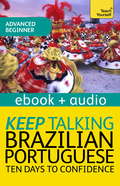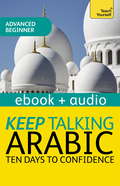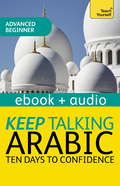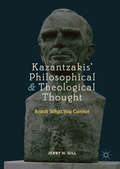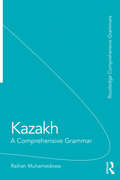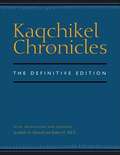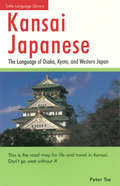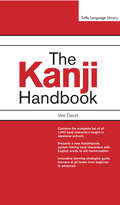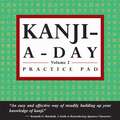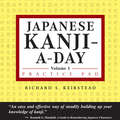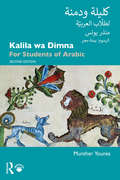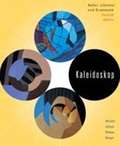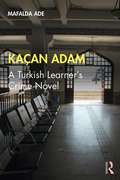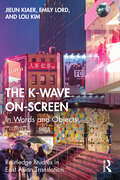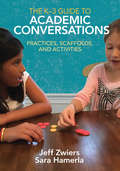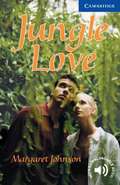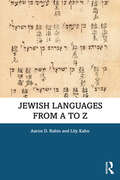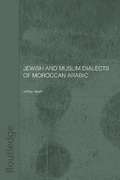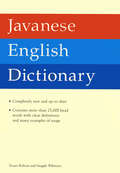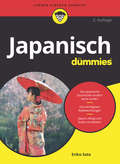- Table View
- List View
Keep Talking Brazilian Portuguese Audio Course - Ten Days to Confidence: Enhanced Edition
by Sue Tyson-Ward Ethel Pereira RowbothamIf you already have the basics and want to learn more Brazilian Portuguese, this advanced beginner audio course will boost your confidence to understand and speak Brazilian Portuguese.Practise the most frequent words and expressions for:-staying at a hotel-meeting people-talking about sports and hobbies-shopping at the market-talking on the phone-going to a restaurant-shopping for clothes-going out for the evening-reporting a theft-booking an excursion.You'll progress in your understanding by working out language patterns for yourself, personalize your Brazilian Portuguese with interactive role-plays and perfect your pronunciation to sound more natural.Keep Talking Brazilian Portuguese - Ten Days to Confidence maps to A1 of the Common European Framework of Reference (CEFR) for languages.Rely on Teach Yourself, trusted by language learners for over 75 years.
Keep Talking Arabic Audio Course - Ten Days to Confidence: Advanced beginner's guide to speaking and understanding with confidence
by Jane Wightwick Mahmoud GaafarIf you already have the basics and want to learn more Arabic, this advanced beginner audio course will boost your confidence to understand and speak Arabic.Practise the most frequent words and expressions for:-explaining where you are from-explaining what you do-asking about sightseeing-talking about hobbies-describing family photos-giving compliments and congratulating-describing your trip-talking about holiday activities-talking about what you enjoyed-offering help.You'll progress in your understanding by working out language patterns for yourself, personalize your Arabic with interactive role-plays and perfect your pronunciation to sound more natural.Keep Talking Arabic - Ten Days to Confidence maps to A1 of the Common European Framework of Reference (CEFR) for languages.Rely on Teach Yourself, trusted by language learners for over 75 years.
Keep Talking Arabic Audio Course - Ten Days to Confidence: Enhanced Edition
by Jane Wightwick Mahmoud GaafarIf you already have the basics and want to learn more Arabic, this advanced beginner audio course will boost your confidence to understand and speak Arabic.Practise the most frequent words and expressions for:-explaining where you are from-explaining what you do-asking about sightseeing-talking about hobbies-describing family photos-giving compliments and congratulating-describing your trip-talking about holiday activities-talking about what you enjoyed-offering help.You'll progress in your understanding by working out language patterns for yourself, personalize your Arabic with interactive role-plays and perfect your pronunciation to sound more natural.Also included is a handy phrasebook and a PDF coursebook for reading and writing practice.Keep Talking Arabic - Ten Days to Confidence maps to A1 of the Common European Framework of Reference (CEFR) for languages.Rely on Teach Yourself, trusted by language learners for over 75 years.
Kazantzakis’ Philosophical and Theological Thought: Reach What You Cannot
by Jerry H. GillThis book explores the philosophical and theological thought of Nikos Kazantzakis. Kazantzakis is a well-known and highly influential Greek writer, having authored such works as Zorba the Greek and The Last Temptation of Christ, among many others. This volume focuses on the over-arching themes of Kazantzakis’ work, namely the importance of the natural world, the nature of humanity, and the nature of God, by means of an analysis of his major novels and other writings. Along the way attention is given to the views of the important scholars who have interacted with Kazantzakis’s works, including Peter Bien, Darren Middleton, and Daniel Dombrowski.
Kazakh: A Comprehensive Grammar (Turcologica Ser. #102)
by Raikhangul MukhamedovaKazakh: A Comprehensive Grammar is the first thorough analysis of Kazakh to be published in English. The volume is systematically organized to enable users to find information quickly and easily, and provides a thorough understanding of Kazakh grammar, with special emphasis given to syntax. Features of this book include: descriptions of phonology, morphology and syntax; examples from contemporary usage; tables summarizing discussions, for reference; a bibliography of works relating to Kazakh. Kazakh: A Comprehensive Grammar reflects the richness of the language, focusing on spoken and written varieties in post-Soviet Kazakhstan. It is an essential purchase for all linguists and scholars interested in Kazakh or in Turkic languages as well as advanced learners of Kazakh.
Kaqchikel Chronicles: The Definitive Edition
by Judith M. Maxwell Robert M. Hill IIThe collection of documents known as the Kaqchikel Chronicles consists of rare highland Maya texts, which trace Kaqchikel Maya history from their legendary departure from Tollan/Tula through their migrations, wars, the Spanish invasion, and the first century of Spanish colonial rule. The texts represent a variety of genres, including formal narrative, continuous year-count annals, contribution records, genealogies, and land disputes. While the Kaqchikel Chronicles have been known to scholars for many years, this volume is the first and only translation of the texts in their entirety. The book includes two collections of documents, one known as the Annals of the Kaqchikels and the other as the Xpantzay Cartulary. The translation has been prepared by leading Mesoamericanists in collaboration with Kaqchikel-speaking linguistic scholars. It features interlinear glossing, which allows readers to follow the translators in the process of rendering colonial Kaqchikel into modern English. Extensive footnoting within the text restores the depth and texture of cultural context to the Chronicles. To put the translations in context, Judith Maxwell and Robert Hill have written a full scholarly introduction that provides the first modern linguistic discussion of the phonological, morphological, syntactic, and pragmatic structure of sixteenth-century Kaqchikel. The translators also tell a lively story of how these texts, which derive from pre-contact indigenous pictographic and cartographic histories, came to be converted into their present form.
Kansai Japanese
by Peter TseThis volume seeks to teach the Japanese language as it is really spoken in the region of Japan, which includes Osaka, Kyoto, Hiroshima and Nagoya, the home of the Japanese auto industry.
The Kanji Handbook
by Vee DavidThe Kanji Handbook is a revolutionary new learning technique for students of the Japanese language. This innovative book presents the concept and application of "KanjiHybrids", a teaching tool created by the author to help non-Japanese speakers learn Kanji. Simply put, Vee David has linked the 1,945 most commonly used Kanji characters with English words to form one integral unit, a "Kanji Hybrid". Using mnemonics as a learning tool, the author has replaced the first letter of an English word with the Kanji for that word in an effort to help students memorize difficult Kanji characters.Employing learning strategies that will aid students from beginning to advanced levels, The Kanji Handbook is an exciting new entry into the difficult world of Japanese language learning.
The Kanji Handbook
by Vee DavidThe Kanji Handbook is a revolutionary new learning technique for students of the Japanese language. This innovative book presents the concept and application of "KanjiHybrids", a teaching tool created by the author to help non-Japanese speakers learn Kanji. Simply put, Vee David has linked the 1,945 most commonly used Kanji characters with English words to form one integral unit, a "Kanji Hybrid". Using mnemonics as a learning tool, the author has replaced the first letter of an English word with the Kanji for that word in an effort to help students memorize difficult Kanji characters.Employing learning strategies that will aid students from beginning to advanced levels, The Kanji Handbook is an exciting new entry into the difficult world of Japanese language learning.
Kanji-A-Day Practice Pad Volume 2
by Periplus Editors"An easy and effective way of steadily building up your kanji."-Kenneth G. Henshall, A Guide to Remembering Japanese CharactersThis calendar-like practice pad allows you to effectively practice basic-intermediate Japanese kanji and learn a year's wroth of kanji in just minutes a day.Although more people are studying the Japanese language than ever before, others are still wary of starting because they believe, "it's too difficult." But Kanji-A-Day, Volume 2 will show beginning-intermediate students that learning Japanese kanji is highly manageable when absorbed in small doses. It will help intermediate and upper-intermediate Japanese learners review and improve upon their past studies and practice Kanji every day. Japanese kanji are fascinating pictographic characters that were originally adopted from written Chinese. After a few weeks of gradual progress your ability to read Kanji, write Kanji and pronounce Japanese will grow tremendously.This calendar like desk companion starts with the most basic Kanji and builds upon itself, one day at a time. For easy reference and review, a booklet listing the 365 kanji is included. Each of the 365 pages contain these six components:The featured Japanese kanji character. The English meaning. The readings written in Japanese script (Hiragana). Related compounds with their meanings and readings. Stroke-order diagrams. 28 practice squares.To get started with Kanji-A-Day, turn to Day One and begin by studying the character, its readings, meanings and sample compounds. Then tear off the sheet and, using the stroke -order guide, practice writing the character in the spaces provided. In a matter of days you'll be on your way to reading and writing kanji with ease!
Kana-a-Day Practice Pad
by Richard S. KeirsteadMaster hiragana and katakana in just minutes a day withKana A-Day Practice Pad. Perfect for both beginners studying the Japanese language and those wishing to hone their kana writing skills, this pad introduces one new kana on each sheet, with readings, stroke order, and sample vocabulary words. All hiragana and katakana are included, along with their sound changes and combinations. For easy reference and review, a booklet listing all kana is included.
Kalila wa Dimna: For Students of Arabic
by Munther YounesSpecifically designed for students of Arabic, this fully illustrated rendition of the Arabic literary classic enhances students’ reading, listening, speaking, and writing skills through the medium of these fun, engaging, and culturally relevant tales. The first part of this second edition follows the original order of the stories, with new vocabulary explained in footnotes throughout. In the second part, grammar explanations and a wealth of exercises provide ample opportunities for readers to improve their understanding of the stories and strengthen their command of Arabic grammar and Arabic writing. The audio material, containing the texts of the stories read by native speakers, is available to download free online to help develop the learner’s listening skills. Suitable for both class use and independent study, Kalila wa Dimna: for Students of Arabic is a must for all intermediate to advanced students wishing to enhance their language skills and discover one of the most popular pieces of Arabic literature ever written.
Kaleidoskop: Kultur, Literatur und Grammatik
by Jack Moeller Winnifred R. Adolph Barbara Mabee Simone BergerKaleidoskop is essentially two books in one: a cultural and literary reader with a comprehensive review of grammar. This combination allows maximum flexibility for instructors to design their own programs. The 10 topics of the Lekt're section contain a variety of texts and activities, and the 10 Kapitel of the self-contained grammar section (Grammatik) allow instructors to work with the grammar topics in whatever order they choose; the grammar chapters may be treated independently of the reading chapters or used concurrently with the Themen of the same number. Given these materials the instructor can provide a learner-centered classroom with activities that lend themselves to cooperative learning. Kaleidoskop features a flexible four-skills, learner-centered approach that promotes communication and focuses on the literature and culture of the German-speaking world. Reading plays an important role in this text, with exercises for listening, speaking and writing revolving around the wide range of authentic reading selections. These texts are authentic and include advertisements, charts, newspaper and magazine articles, letters, e-mails, forum mails, polls, interviews, biographies, songs, poems, and fiction.
Kaleidoskop: Kultur, Literatur und Grammatik
by Jack Moeller Barbara Mabee Simone Berger Winnifred R. AdolphKaleidoskop is essentially two books in one: a cultural and literary reader with a comprehensive review of grammar. This combination allows maximum flexibility for instructors to design their own programs. The 10 topics of the LektÜre section contain a variety of texts and activities and the 10 Kapitel of the self-contained grammar section (Grammatik) allow instructors to work with the grammar topics in whatever order they choose; the grammar chapters may be treated independently of the reading chapters or used concurrently with the Themen of the same number. Given these materials the instructor can provide a learner-centered classroom with activities that lend themselves to cooperative learning. Kaleidoskop features a flexible four-skills, learner-centered approach that promotes communication and focuses on the literature and culture of the German-speaking world. Reading plays an important role in this text, with exercises for listening, speaking and writing revolving around the wide range of authentic reading selections. These texts are authentic and include advertisements, charts, newspaper and magazine articles, letters, e-mails, forum mails, polls, interviews, biographies, songs, poems, and fiction. New! Updated readings in the LektÜre section feature high-interest selections, including seven new cultural texts, three new poems, and a modern short story from a young writer. New! Situation-based grammar examples relate grammar to real-world scenarios so that students see how form serves function. New! Enhanced integration of color inserts supports learning and assists instructors with in-class integration of the material. New! Marginal icons inform students as to the purpose of the activity they are doing (partner or group work) and refer them to additional multimedia support activities, such as readings on the In-text Audio CD and grammar and web-search exercises on the web site. Flexible organization offers two books in one: a cultural and literary reader with a comprehensive grammar review. Strong correlation between the LektÜre and Grammatik features 10 Themen in the reading section that correspond with the 10 Kapitel in the grammar review. LektÜre also provides a systematic review of the literary texts and practice of the grammar featured in each reading. Grammatik offers a clear and concise format for easy reference, and provides contextualized, proficiency-oriented grammar practice. Pre- and post-reading activities provide important background information and strategies to prepare students to read, understand, discuss, and write about authentic texts.
Kaçan Adam: A Turkish Learner’s Crime Novel
by Mafalda AdeAimed at intermediate Turkish learners, Kaçan Adam: A Turkish Learner’s Crime Novel is a short mystery / detective story in idiomatic Turkish complete with exercises, vocabulary and grammar review. Over the course of 24 lively chapters, it follows the fate of former intelligence officer Erkan Demirel, who has been convicted of selling secret military documents but who manages to escape from prison and embarks on a quest to prove his innocence… For use either as a supplement to classroom instruction (CEFR A2-B1 and ACTFL, Lower Intermediate Level) or individually, this book will guide students through their first complete novel in Turkish while revising and reinforcing key points of modern Turkish grammar and expression.
The K-Wave On-Screen: In Words and Objects (Routledge Studies in East Asian Translation)
by Jieun Kiaer Emily Lord Loli KimThe K-Wave On-Screen provides an engaging and accessible exploration of the meaning of ‘K-’ through the lens of words and objects in K-dramas and K-films. Once a small subculture known only to South Korea’s East Asian neighbours, the Korean Wave has exploded in popularity around the globe in the last decade. Its success has been fuelled by social media and the advanced technological capabilities of South Korea. With #KpopTwitter having amassed 7.8 billion tweets and with K-films receiving acclaim from major award ceremonies, the K-wave is now a global cultural phenomenon. This book touches on globally popular productions, such as Parasite (2019), Squid Game (2021), Pachinko (2022), SKY Castle (2018), and Kim Ji-young: Born 1982 (2019) to highlight that K- has departed from the traditional meaning of ‘Korean-ness’ to become a new, globally-informed, and hybrid entity. This book will be of interest to students in East Asian studies, and those engaged with Korean language learning. The book will also appeal to those interested in Korean culture and media.
The K-3 Guide to Academic Conversations: Practices, Scaffolds, and Activities
by Jeff Zwiers Sara R. Hamerla“For thousands of years people have been using the skills we describe in this book to engage in conversations with others. What isn’t as prevalent, however, is instruction--especially in primary grades—in which we engage students in productive conversations about academic ideas. This book fills that very big need.” --Jeff Zwiers & Sara Hamerla Talk about content mastery . . . Primary teachers, you won’t want to miss this: if you’re looking for a single resource to foster purposeful content discussions and high-quality interpersonal engagement, then put Jeff Zwiers and Sara Hamerla’s K-3 Guide to Academic Conversations at the top of your reading list. Whether your students love to talk or not, all must be equipped with key conversation skills such as active listening, taking turns, posing, clarifying, supporting with examples, and arguing ideas. This ready resource comes packed with every imaginable tool you could need to make academic conversations part of your everyday teaching: Sample lesson plans and anchor charts Guidelines for creating effective prompts Applications across content areas, with corresponding assessments Rubrics and protocols for listening to student speech Transcripts of conversations and questions for reflection Companion website with video and downloadable resources Tens of thousands of students in the upper grades have reaped the benefits of academic conversations: high-quality face-to-face interactions, increased motivation, stronger collaborative argumentation skills, and better understanding and retention of content. The K-3 Guide to Academic Conversations is that resource for providing your primary students with the same powerful learning opportunities.
The K-3 Guide to Academic Conversations: Practices, Scaffolds, and Activities
by Jeff Zwiers Sara R. Hamerla“For thousands of years people have been using the skills we describe in this book to engage in conversations with others. What isn’t as prevalent, however, is instruction--especially in primary grades—in which we engage students in productive conversations about academic ideas. This book fills that very big need.” --Jeff Zwiers & Sara Hamerla Talk about content mastery . . . Primary teachers, you won’t want to miss this: if you’re looking for a single resource to foster purposeful content discussions and high-quality interpersonal engagement, then put Jeff Zwiers and Sara Hamerla’s K-3 Guide to Academic Conversations at the top of your reading list. Whether your students love to talk or not, all must be equipped with key conversation skills such as active listening, taking turns, posing, clarifying, supporting with examples, and arguing ideas. This ready resource comes packed with every imaginable tool you could need to make academic conversations part of your everyday teaching: Sample lesson plans and anchor charts Guidelines for creating effective prompts Applications across content areas, with corresponding assessments Rubrics and protocols for listening to student speech Transcripts of conversations and questions for reflection Companion website with video and downloadable resources Tens of thousands of students in the upper grades have reaped the benefits of academic conversations: high-quality face-to-face interactions, increased motivation, stronger collaborative argumentation skills, and better understanding and retention of content. The K-3 Guide to Academic Conversations is that resource for providing your primary students with the same powerful learning opportunities.
Jungle Love (Cambridge English Readers #Level 5)
by Margaret JohnsonAward-winning original fiction for learners of English. At seven levels, from Starter to Advanced, this impressive selection of carefully graded readers offers exciting reading for every student's capabilities. On an adventure holiday in the Caribbean, Lisa and Jennifer are sharing a room. They are very different people and do not get on. However, they do have something in common: they are both attracted to Ian. And Ian likes both of them. But what about Ian's girlfriend, Caroline? And then there's Pete and of course, Gary...
Jewish Languages from A to Z
by Lily Kahn Aaron D. RubinJewish Languages from A to Z provides an engaging and enjoyable overview of the rich variety of languages spoken and written by Jews over the past three thousand years. The book covers more than 50 different languages and language varieties. These include not only well-known Jewish languages like Hebrew, Yiddish, and Ladino, but also more exotic languages like Chinese, Esperanto, Malayalam, and Zulu, all of which have a fascinating Jewish story to be told. Each chapter presents the special features of the language variety in question, a discussion of the history of the associated Jewish community, and some examples of literature and other texts produced in it. The book thus takes readers on a stimulating voyage around the Jewish world, from ancient Babylonia to 21st-century New York, via such diverse locations as Tajikistan, South Africa, and the Caribbean. The chapters are accompanied by numerous full-colour photographs of the literary treasures produced by Jewish language-speaking communities, from ancient stone inscriptions to medieval illuminated manuscripts to contemporary novels and newspapers. This comprehensive survey of Jewish languages is designed to be accessible to all readers with an interest in languages or history, regardless of their background—no prior knowledge of linguistics or Jewish history is assumed.
Jewish and Muslim Dialects of Moroccan Arabic (Routledge Arabic Linguistics Series)
by Jeffrey HeathThis is a comprehensive study of the Jewish and Muslim dialect networks of Morocco in its traditional boundaries, covering twenty-two Muslim and some thirty Jewish dialects of Moroccan Arabic.
Javanese English Dictionary
by Stuart Robson Singgih WibisonoThis is the most complete and and up-to-date Javanese dictionary available.The Javanese-English Dictionary is the only reference source to provide a complete listing, with clear English translations and explanations, of all current terms used in modern Javanese. It covers the whole vocabulary needed both for everyday communication and in order to read published materials, and is a resource long needed by language scholars, students of Javanese history and society and visitors with an interest in the traditional culture of Java. With more than 25,000 headwords, it also includes local forms likely to be encountered in travel, specialist terms associated with the traditional arts of the area and obsolete words still to be found in literature.The dictionary also contains clear explanations of Javanese culture, folklore and religious practices. Users will gain an insight into traditional Javanese cuisine, costume, crafts and the performing arts, and will be able to identify local flora and fauna.Javanese-English Dictionary includes:Completely new and up-to dateContains more than 25,000 heard words with clear definitionsExtensive examples of usage.Information on Javanese culture and historyUnique Javanese idioms and expressionsSpecial treatment of the unique elements Javanese grammar and syntax
Javanese English Dictionary
by Singgih Wibisono Stuart RobsonThis is the most complete and and up-to-date Javanese dictionary available.The Javanese-English Dictionary is the only reference source to provide a complete listing, with clear English translations and explanations, of all current terms used in modern Javanese. It covers the whole vocabulary needed both for everyday communication and in order to read published materials, and is a resource long needed by language scholars, students of Javanese history and society and visitors with an interest in the traditional culture of Java. With more than 25,000 headwords, it also includes local forms likely to be encountered in travel, specialist terms associated with the traditional arts of the area and obsolete words still to be found in literature.The dictionary also contains clear explanations of Javanese culture, folklore and religious practices. Users will gain an insight into traditional Javanese cuisine, costume, crafts and the performing arts, and will be able to identify local flora and fauna.Javanese-English Dictionary includes:Completely new and up-to dateContains more than 25,000 heard words with clear definitionsExtensive examples of usage.Information on Javanese culture and historyUnique Javanese idioms and expressionsSpecial treatment of the unique elements Javanese grammar and syntax
Javanese English Dictionary
by Singgih Wibisono Stuart RobsonThis is the most complete and and up-to-date Javanese dictionary available.The Javanese-English Dictionary is the only reference source to provide a complete listing, with clear English translations and explanations, of all current terms used in modern Javanese. It covers the whole vocabulary needed both for everyday communication and in order to read published materials, and is a resource long needed by language scholars, students of Javanese history and society and visitors with an interest in the traditional culture of Java. With more than 25,000 headwords, it also includes local forms likely to be encountered in travel, specialist terms associated with the traditional arts of the area and obsolete words still to be found in literature.The dictionary also contains clear explanations of Javanese culture, folklore and religious practices. Users will gain an insight into traditional Javanese cuisine, costume, crafts and the performing arts, and will be able to identify local flora and fauna.Javanese-English Dictionary includes:Completely new and up-to dateContains more than 25,000 heard words with clear definitionsExtensive examples of usage.Information on Javanese culture and historyUnique Javanese idioms and expressionsSpecial treatment of the unique elements Javanese grammar and syntax
Japanisch für Dummies (Für Dummies)
by Eriko SatoSie haben angefangen, Japanisch zu lernen, haben regelmäßig Kontakt zu japanischen Geschäftspartnern oder wollen Ihren Urlaub in Japan verbringen? In diesem Buch erfahren Sie alles über die Besonderheiten der Sprache, erhalten eine kurze Einführung in Betonung und Grammatik und lernen anhand von vielen typischen Alltagssituationen Japanisch zu sprechen. So können Sie sich nicht nur auf Japanisch vorstellen und Small Talk betreiben, sondern bekommen auch beim Einkaufen und im Restaurant das, was Sie wollen. Mit der CD zum Buch können Sie viele Sprachübungen anhören und nachsprechen.
